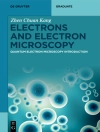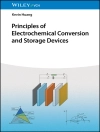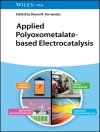In Volume XV in the series ‘Advances in Electrochemical Science and Engineering’ various leading experts from the field of electrochemical engineering share their insights into how different experimental and computational methods are used in transferring molecular-scale discoveries into processes and products. Throughout, the focus is on the engineering problem and method of solution, rather than on the specific application, such that scientists from different backgrounds will benefit from the flow of ideas between the various subdisciplines.
A must-read for anyone developing engineering tools for the next-generation design and control of electrochemical process technologies, including chemical, mechanical and electrical engineers, as well as chemists, physicists, biochemists and materials scientists.
Mục lục
Series Preface XI
Preface XIII
List of Contributors XVII
1 The Role of Electrochemical Engineering in Our Energy Future 1
L. Louis Hegedus
References 5
2 The Path from Invention to Product for the Magnetic Thin Film Head 7
Lubomyr T. Romankiw and Sol Krongelb
2.1 Introduction 7
2.2 The State of the Art in the 1960s 8
2.2.1 The Processor 10
2.2.2 Memory 10
2.2.3 Data Storage 11
2.2.4 Electroplating Technology 14
2.3 Finding the Right Path to Production 14
2.3.1 First Demonstrations of a Thin Film Head 14
2.3.2 Interdisciplinary Design of a Functional Head 16
2.3.3 Early Tie-in to Manufacturing 18
2.3.4 The Integration of Many Inventions 21
2.4 Key Inventions for Thin Film Head Production 22
2.4.1 Device Structures 24
2.4.2 The Plating Process 24
2.4.2.1 The Paddle Cell 25
2.4.2.2 The Electroplating Bath, Deposition Parameters, and Controls 29
2.4.3 Patterning 33
2.4.3.1 Through-mask Plating 33
2.4.3.2 Frame Plating 37
2.4.3.3 Ancillary Issues in Pattern Plating 41
2.4.4 Materials 44
2.4.4.1 Magnetic Materials Studies 44
2.4.4.2 Hard-Baked Resist as Insulation 45
2.5 Concluding Thoughts 50
2.5.1 Fabrication Technology – the Key to a Manufactured Product 50
2.5.2 Matching Product and Process 51
2.5.3 An Interdisciplinary Combination of Science, Engineering, and Intuition 52
Acknowledgments 55
References 55
3 Electrochemical Surface Processes and Opportunities for Material Synthesis 59
Stanko R. Brankovic and Giovanni Zangari
3.1 Introduction 59
3.2 Underpotential Deposition (UPD) 60
3.3 Metal Deposition via Surface-Limited Redox Replacement of Underpotentially Deposited Metal Layer 63
3.3.1 General Description 63
3.3.2 Stoichiometry of SLRR Reactions and Deposition Process 64
3.3.3 Driving Force for SLRR Reaction and Nucleation Rate of Depositing Metal 66
3.3.4 Reaction Kinetics of Surface-Limited Redox Replacement 69
3.3.5 Future Directions 74
3.4 Underpotential Codeposition (UPCD) 76
3.4.1 Energetics: Beyond the Thermodynamic Approximation 78
3.4.1.1 Ion Adsorption at the Electrode/Electrolyte Interface 78
3.4.1.2 Potential of Zero Charge (PZC) 79
3.4.1.3 Surface Defects, Reconstruction, and Segregation 79
3.4.1.4 Atomistic Description of the Growth Process 80
3.4.2 Kinetics 80
3.4.3 Equilibrium Alloy Structure and Phase Formation 85
3.4.3.1 Binary Alloys Forming Solid Solutions and Ordered Compounds 86
3.4.3.2 Intermetallic Compounds 87
3.4.3.3 Alloys Immiscible in the Bulk 90
3.4.4 Structure and Morphology of UPCD Alloy Films 92
3.4.4.1 Crystallographic Structure and Microstructure 92
3.4.4.2 Film Morphology 94
3.4.5 Applications of UPCD Growth Methods 95
3.4.5.1 Catalysis and Electrocatalysis 96
3.4.5.2 Photovoltaics 97
3.4.5.3 Magnetic Recording and Microsystems 99
Acknowledgments 101
References 101
4 Mathematical Modeling of Self-Organized Porous Anodic Oxide Films 107
Kurt R. Hebert
4.1 Introduction 107
4.2 Phenomenology of Porous Anodic Oxide Formation 108
4.3 Mechanisms for Porous Anodic Oxide Formation 118
4.4 Elements of Porous Anodic Oxide Models 120
4.4.1 Ionic Migration Fluxes and Field Equations 120
4.4.2 Bulk Motion of Oxide 122
4.4.3 Interfacial Reactions 123
4.4.4 Boundary Conditions 125
4.4.5 Interface Motion 126
4.5 Modeling Results 128
4.5.1 Steady-State Porous Layer Growth 128
4.5.2 Linear Stability Analysis 130
4.5.3 Morphology Evolution 133
4.6 Summary and Outlook 141
References 141
5 Engineering of Self-Organizing Electrochemistry: Porous Alumina and Titania Nanotubes 145
Chong-Yong Lee and Patrik Schmuki
5.1 Introduction 145
5.2 Formation and Growth of Ti O2 and Al2O3 Nanotubes/Pores 147
5.2.1 General Aspects of Electrochemical Anodization and Self-Organization 147
5.2.2 Some Critical Factors/Aspects in the Self-Organization Phenomenology 149
5.2.2.1 Duplex or Double Wall Structure of Al2O3 and Ti O2 152
5.2.2.2 Tubes versus Pores 153
5.2.2.3 Geometry Control 154
5.3 Improved Ordering via Nanopatterning 161
5.3.1 Al2O3 162
5.3.2 Ti O2 163
5.4 Crystallinity and Composition 164
5.5 Applications 165
5.5.1 Anodic Al2O3 as Template Materials 166
5.5.2 Anodic Ti O2 for Dye-Sensitized Solar Cells 168
5.5.2.1 Tube Geometry 170
5.5.2.2 Crystallinity 173
5.5.2.3 Approaches to Enhance the Surface Area 174
5.5.2.4 Doping 175
5.5.2.5 Single Wall Morphology 177
5.5.3 Prospect for Commercialization 177
5.5.3.1 Processing Speed 177
5.5.3.2 Design: Backside versus Front-Side Illumination 178
5.5.3.3 Flexible Substrate 180
5.5.3.4 Scale-Up 180
5.5.3.5 Long-Term Stability 181
5.6 Conclusions 181
References 182
6 Diffusion-Induced Stress within Core–Shell Structures and Implications for Robust Electrode Design and Materials Selection 193
Mark W. Verbrugge, Yue Qi, Daniel R. Baker, and Yang-Tse Cheng
6.1 Introduction 193
6.2 Ab initio Simulations: Informing Continuum Models 195
6.3 Governing Equations for the Continuum Model 198
6.3.1 Thermodynamics 198
6.3.2 Solute Diffusion 199
6.3.3 Solid Mechanics 200
6.3.4 Analytic Solution for Initial Stress Distribution 205
6.4 Results and Discussion 208
6.4.1 Initial Condition 209
6.4.2 Transient Behavior 212
6.4.3 Application to a Host-SEI Core–Shell System 215
6.5 Summary and Conclusions 221
References 221
7 Cost-Based Discovery for Engineering Solutions 227
Brian L. Spatocco and Donald R. Sadoway
7.1 Introduction 227
7.1.1 The Winds of Change: Integrating Intermittent Renewables 227
7.1.2 Cost is the Determining Factor 229
7.1.3 The Path Forward 230
7.2 The Liquid Metal Battery as a Grid Storage Solution 230
7.2.1 Principles of Operation 230
7.2.2 Strengths and Weaknesses 231
7.2.2.1 Scientific Advantages 231
7.2.2.2 Technology Scale-Up 232
7.2.2.3 Market Flexibility 233
7.2.3 Review of Competitive Technologies 234
7.2.4 Down-Selection 235
7.2.4.1 Cost 235
7.2.4.2 Temperature 237
7.2.4.3 Scalability 239
7.3 Historical Odyssey 241
7.3.1 Molten Salts in Sodium Electrodeposition 241
7.3.2 Molten Salts in Nuclear Reactor Development 245
7.3.2.1 Aggregated Properties 245
7.3.2.2 Corrosion Mechanisms 246
7.3.3 Molten Salts in Energy Storage Devices 252
7.3.4 The Window of Opportunity 255
7.4 Project Description 256
7.5 Conclusion 257
References 257
8 Multiscale Study of Electrochemical Energy Systems 263
Hany El-Sayed, Alois Knoll, and Ulrich Stimming
8.1 Introduction 263
8.2 Architectures of Energy Systems 265
8.2.1 The System and Its Boundary Conditions 266
8.2.2 Architectures of Multiscale Energy Systems 268
8.2.3 Agent-Based Approaches for Run-Time Simulation and Optimization 275
8.3 The Big Picture 281
8.3.1 Centralized versus Decentralized Systems 281
8.3.2 Decentralized Energy Systems: a Closer Look 282
8.4 Storage Components 285
8.4.1 How to Store Energy 285
8.4.2 Selected Energy Storage Devices 286
8.4.2.1 Li-Ion Batteries 286
8.4.2.2 Post Li-Ion Batteries 288
8.4.2.3 Redox Flow Batteries 290
8.4.3 Application to a City Block 291
8.5 Conversion Components, DEFC 292
8.5.1 Introduction to DEFC 292
8.5.2 Ethanol versus Other Fuels 295
8.5.3 Indirect versus Direct Ethanol Fuel Cell 295
8.5.3.1 Effect of Temperature on DEFC Performance 297
8.5.3.2 Stack Hardware and Design 297
8.6 Materials and Molecular Processes 299
8.6.1 DEFC Components 299
8.6.2 MEA and Electrodes 300
8.6.3 DEFC Processes 301
8.6.3.1 Ethanol Oxidation Reaction in Acidic Media 301
8.6.4 Anode Catalysts 303
8.6.4.1 Pt–Sn as DEFC Anode Catalyst 304
8.6.4.2 Ethanol Oxidation Reaction in Alkaline Media 305
8.6.4.3 Elevated Temperature Direct Ethanol Fuel Cell Membranes – Pros and Cons 305
8.6.5 Model Catalysts 308
8.6.5.1 Creating Nanostructured Model Surfaces 309
8.6.5.2 Acidic Media 310
8.6.5.3 Alkaline Media 313
8.6.5.4 A Few Words about Cathode Catalysts (Conventional and Me OH Tolerant Catalysts) 314
8.7 Conclusions – Folding It Back 315
Acknowledgments 316
References 316
Index 323
Giới thiệu về tác giả
Richard C. Alkire is Professor Emeritus of Chemical & Biomolecular Engineering Charles and Dorothy Prizer Chair at the University of Illinois, Urbana, USA. He obtained his degrees at Lafayette College and University of California at Berkeley. He has received numerous prizes, including Vittorio de Nora Award and Lifetime National Associate award from National Academy.
Philip N. Bartlett is Head of the Electrochemistry Section, Deputy Head of Chemistry for Strategy, and Associate Dean for Enterprise in the Faculty of Natural and Environmental Sciences at the University of Southampton. He received his Ph D from Imperial College London and was a Lecturer at the University of Warwick and a Professor for Physical Chemistry at the University of Bath, before moving to his current position. His research interests include bioelectrochemistry, nanostructured materials, and chemical sensors.
Jacek Lipkowski is Professor at the Department of Chemistry and Biochemistry at the University of Guelph, Canada. His research interests focus on surface analysis and interfacial electrochemistry. He has authored over 120 publications and is a member of several societies, including a Fellow of the International Society of Electrochemistry.












